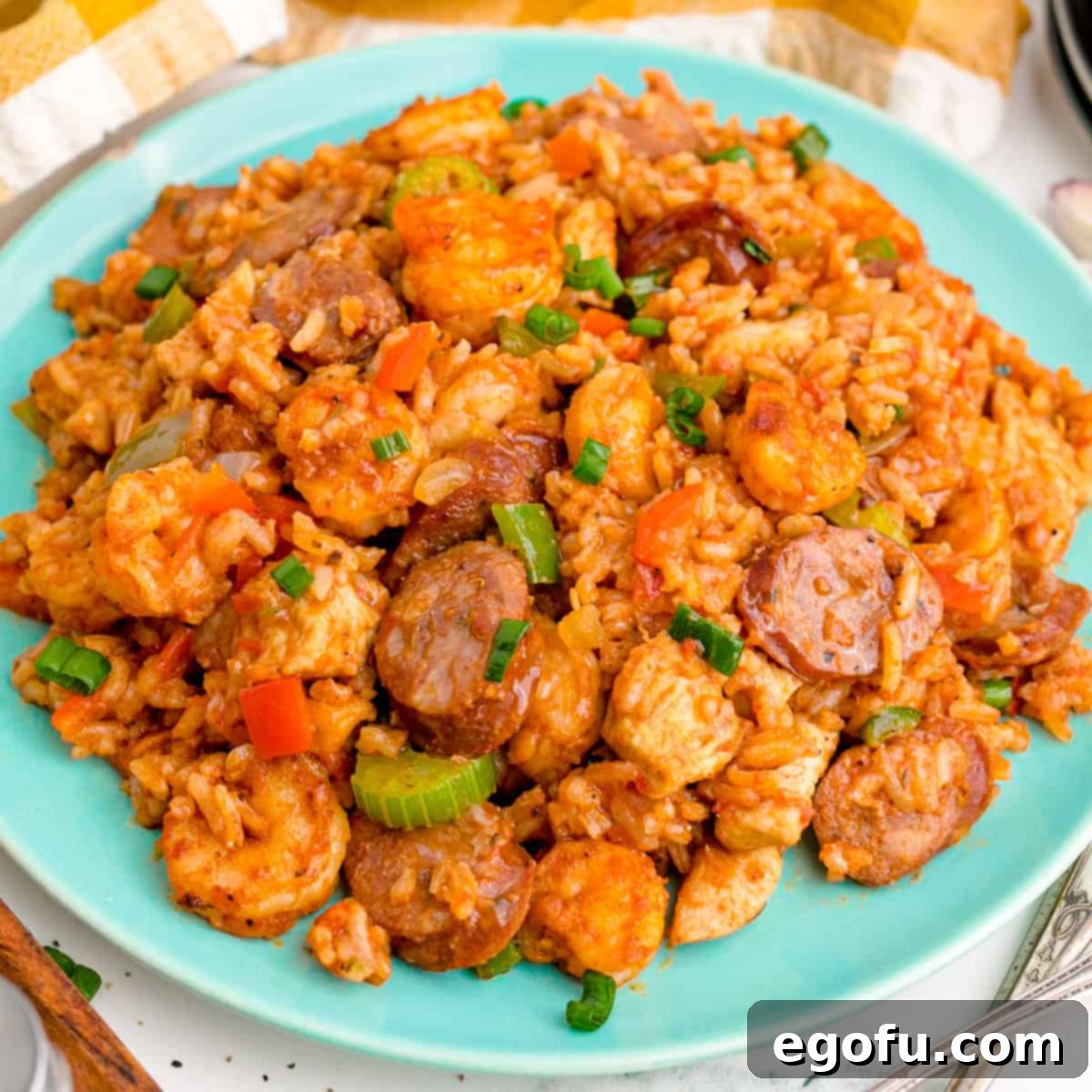A classic Creole and Cajun dish, Louisiana Jambalaya is a vibrant, flavorful, and deeply satisfying recipe that beautifully marries French, Spanish, and West African influences. Found at the heart of New Orleans’ culinary scene, this iconic comfort food is more than just a meal; it’s a celebration of Southern heritage.
The Ultimate Louisiana Jambalaya Recipe: A Culinary Journey to New Orleans
When it comes to soul-warming comfort food, few dishes compare to an expertly crafted Louisiana Jambalaya. This isn’t just any recipe; it’s the culmination of extensive experimentation and a deep respect for authentic Louisiana flavors. My goal was to create a recipe that not only captures the true essence of this beloved dish but also impresses even the most discerning palates, including my friends from Louisiana who know their Jambalaya! This robust dish, loaded with tender chicken, savory Andouille sausage, succulent shrimp, vibrant vegetables, and perfectly cooked rice, is an absolute flavor powerhouse. It promises to be a show-stopping meal for any gathering, leaving your guests craving more. If you cherish the rich traditions of Southern cooking, then preparing this authentic Louisiana Jambalaya recipe is an absolute must.


“I made your Jambalaya recipe a couple months ago and both my husband and I loved it! In fact, I am making it again tonight for Fat Tuesday, as I always like making a Louisiana dish. Thanks so much for sharing your recipe…I didn’t change a thing!”
– Cathy
Frequently Asked Questions About Louisiana Jambalaya
While Andouille is the traditional choice and brings an unmistakable smoky, spicy depth crucial to authentic Jambalaya, you certainly have alternatives if you prefer less spice or a different flavor profile. Excellent substitutes include kielbasa, smoked sausage (like a quality German or Polish sausage), or even chorizo for a different kind of kick. However, for that classic Louisiana taste, especially in Creole-style Jambalaya, Andouille sausage is highly recommended.
The primary distinction between these two beloved Louisiana dishes lies in the rice. In Jambalaya, the rice is cooked directly within the pot with all the other ingredients, absorbing all the rich flavors as it simmers. Gumbo, on the other hand, is a thick, flavorful stew, often made with a dark roux, and is traditionally served over a bed of rice that is cooked separately. Gumbo tends to have a soupier, gravy-like consistency, while Jambalaya is a more cohesive, one-pot rice dish.
Jambalaya is wonderfully versatile and can be prepared in both Creole and Cajun styles, making it truly a dish of both traditions. Creole Jambalaya, often referred to as “red Jambalaya,” typically includes tomatoes or tomato sauce, giving it a reddish hue and a slightly sweeter, richer base. It’s often associated with New Orleans and its diverse culinary heritage. Cajun Jambalaya, or “brown Jambalaya,” usually omits tomatoes, relying instead on a deeper browning of the meats (especially the “holy trinity” of onion, celery, and bell pepper) to achieve its characteristic dark color and robust flavor. Both styles share the foundation of rice, meat, and vegetables, but their specific preparation methods and ingredients vary, offering unique culinary experiences.
Absolutely, using your favorite pre-mixed Cajun seasoning is a convenient option if you’re looking to simplify the spice list. It can effectively replace the individual amounts of paprika, oregano, basil, pepper, thyme, and cayenne pepper. However, this recipe’s specific combination of spices has been carefully balanced to create a nuanced and deeply layered flavor profile that I believe truly elevates this Jambalaya. If you have the time and the spices on hand, I highly recommend trying the exact proportions listed to experience the full depth of flavor intended.
Yes, brown rice lovers will be pleased to know that it can be successfully substituted for white rice in this Louisiana Jambalaya recipe. Keep in mind that brown rice typically requires more liquid and a longer cooking time to become tender. If you opt for brown rice, you will need to adjust the liquid ratio, increasing the chicken broth from 2 cups to approximately 3 cups, and allowing for a longer simmer time until the grains are fully cooked and absorb the liquid.
If, after the initial simmering period, your rice is still too firm or crunchy, don’t panic! This can sometimes happen due to varying heat levels or rice types. Simply add another half cup to a full cup of chicken broth or water to the pot, cover it tightly, and continue to simmer on low heat. Check every 5-10 minutes, stirring gently, until the rice is tender and has absorbed the additional liquid. Avoid over-stirring, which can make the rice mushy.
Louisiana Jambalaya makes fantastic leftovers! To store, transfer any remaining Jambalaya to an airtight container and refrigerate it promptly. It will maintain its delicious flavor and quality for up to 4 days. For longer storage, Jambalaya freezes exceptionally well. Portion it into freezer-safe containers or heavy-duty freezer bags and freeze for up to 3 months. When reheating, be aware that the texture of the shrimp might become slightly softer after freezing and thawing, but the overall dish will still be incredibly flavorful. To defrost, simply move it from the freezer to the refrigerator overnight, then reheat gently on the stovetop or in the microwave.
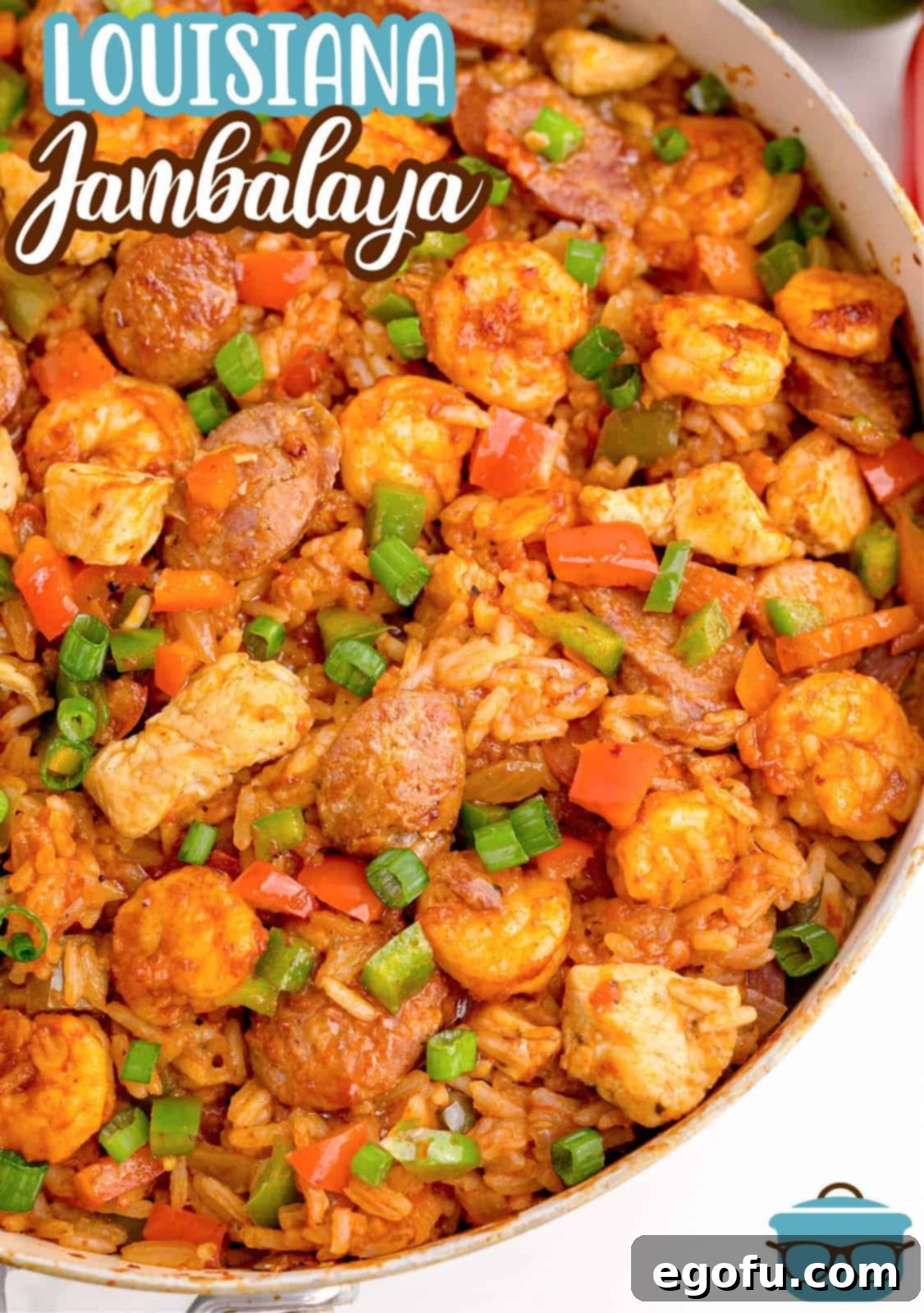
Essential Ingredients for Authentic Louisiana Jambalaya
Crafting the perfect Jambalaya begins with selecting the right ingredients. Here’s what you’ll need to create this flavor-packed Southern classic. Remember, the “holy trinity” (onion, bell pepper, and celery) forms the aromatic foundation of this dish, bringing authentic depth to every spoonful.
- Andouille sausage: For authentic smoky, spicy flavor.
- Chicken breasts (or thighs): Cut into 1-inch pieces, boneless and skinless.
- Onion: Finely diced, part of the “holy trinity.”
- Green bell pepper: Diced, another essential component of the “holy trinity.”
- Celery: Chopped, completing the aromatic foundation.
- Garlic: Minced, for pungent depth.
- Crushed tomatoes: The key to Creole Jambalaya’s signature “red” base.
- Smoked paprika: Adds a beautiful color and a mild smoky flavor.
- Salt and pepper: Essential seasoning to taste.
- Cumin: Enhances the savory notes.
- Dried oregano: Aromatic herb for traditional flavor.
- Dried basil: Sweet and peppery notes.
- Dried thyme: Earthy and slightly minty, complements the other herbs.
- Cayenne pepper (optional): For an extra kick of heat, adjust to your preference.
- Uncooked white rice: Long or short grain (not quick-cooking), the heart of the dish.
- Chicken broth: Provides moisture and flavor for cooking the rice.
- Shrimp: Peeled and deveined, for a delicious seafood addition.
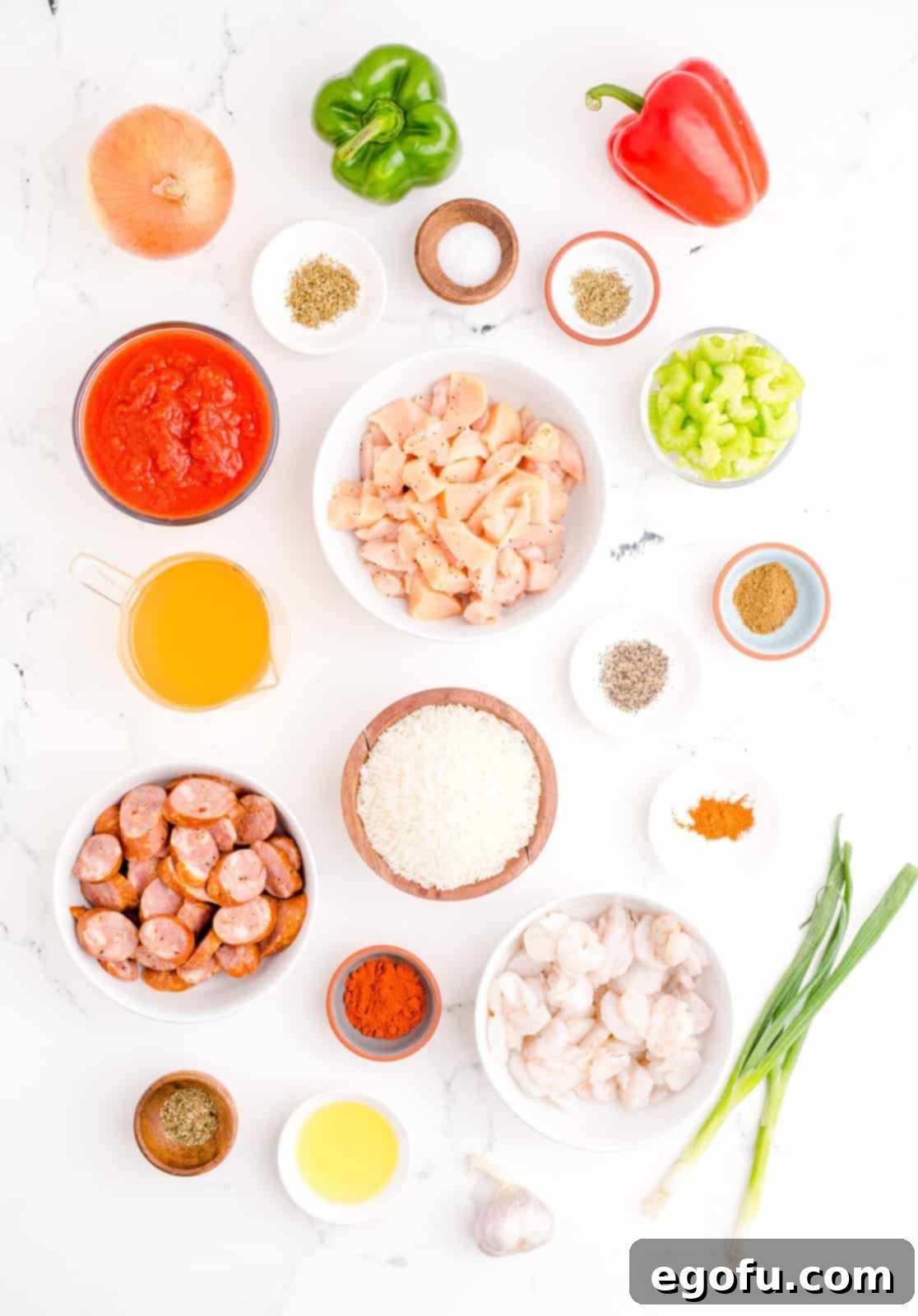
How to Make Authentic Louisiana Jambalaya: Step-by-Step Guide
Follow these detailed steps to create a rich and flavorful Louisiana Jambalaya that will transport your taste buds straight to the heart of Cajun and Creole country. The key is building layers of flavor, so take your time with each stage.
Step 1: Brown the Meats. Heat 1 tablespoon of cooking oil over medium heat in a large Dutch oven or a heavy-bottomed pot. Add the sliced Andouille sausage and the 1-inch pieces of chicken. Sauté them until they are lightly seared and beautifully browned, which usually takes about 5-7 minutes. Browning the meats creates a crucial flavor base known as “fond” at the bottom of the pot, which will be scraped up in later steps.
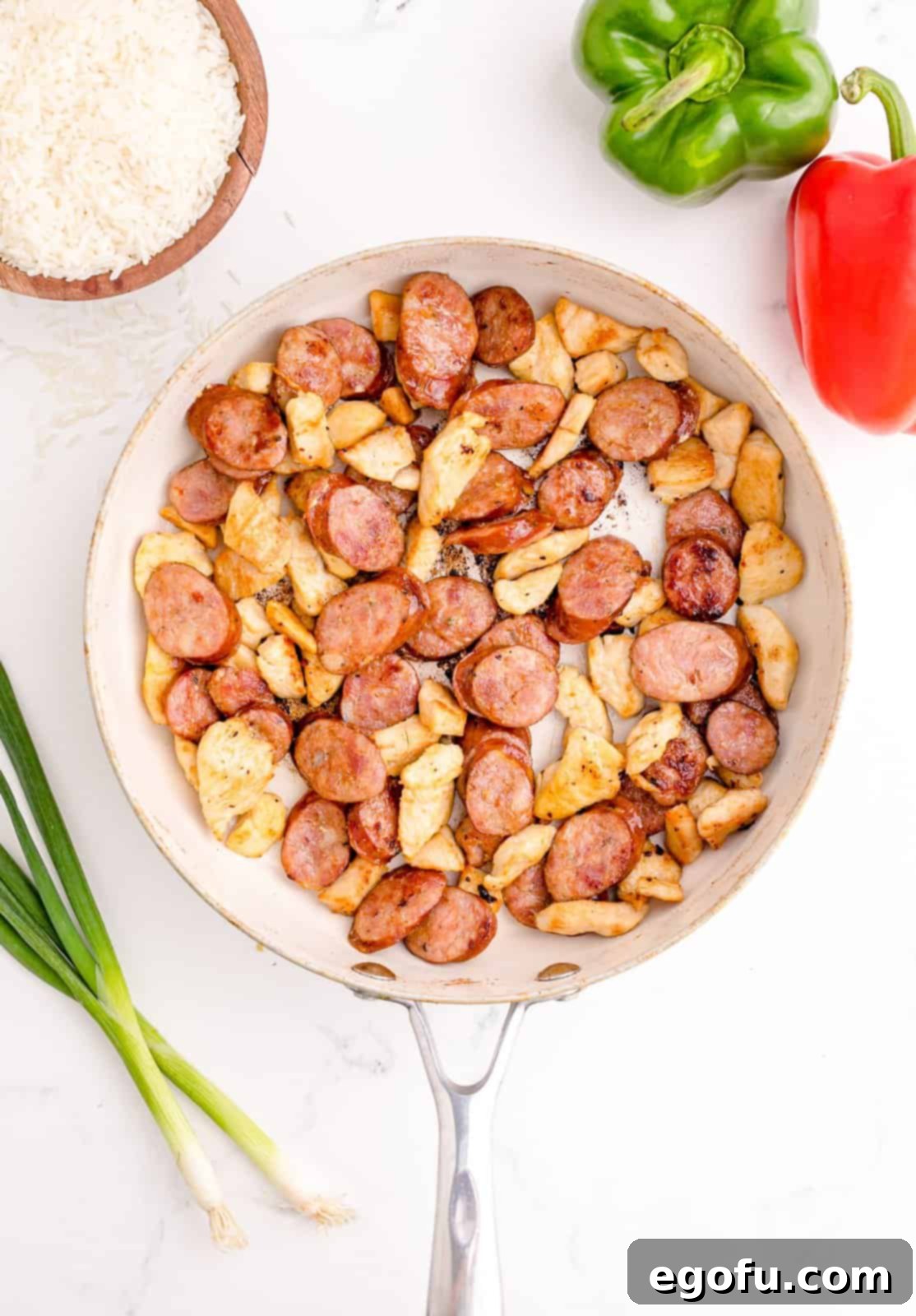
Step 2: Sauté the Holy Trinity. Once the meats are browned, add the finely diced yellow onion, green bell pepper, red bell pepper, and chopped celery (the “holy trinity” of Louisiana cooking) to the pot. Cook these vegetables, stirring occasionally, until the onion softens and becomes translucent, typically 5-8 minutes. This step allows the vegetables to release their aromatic flavors and lightly caramelize.
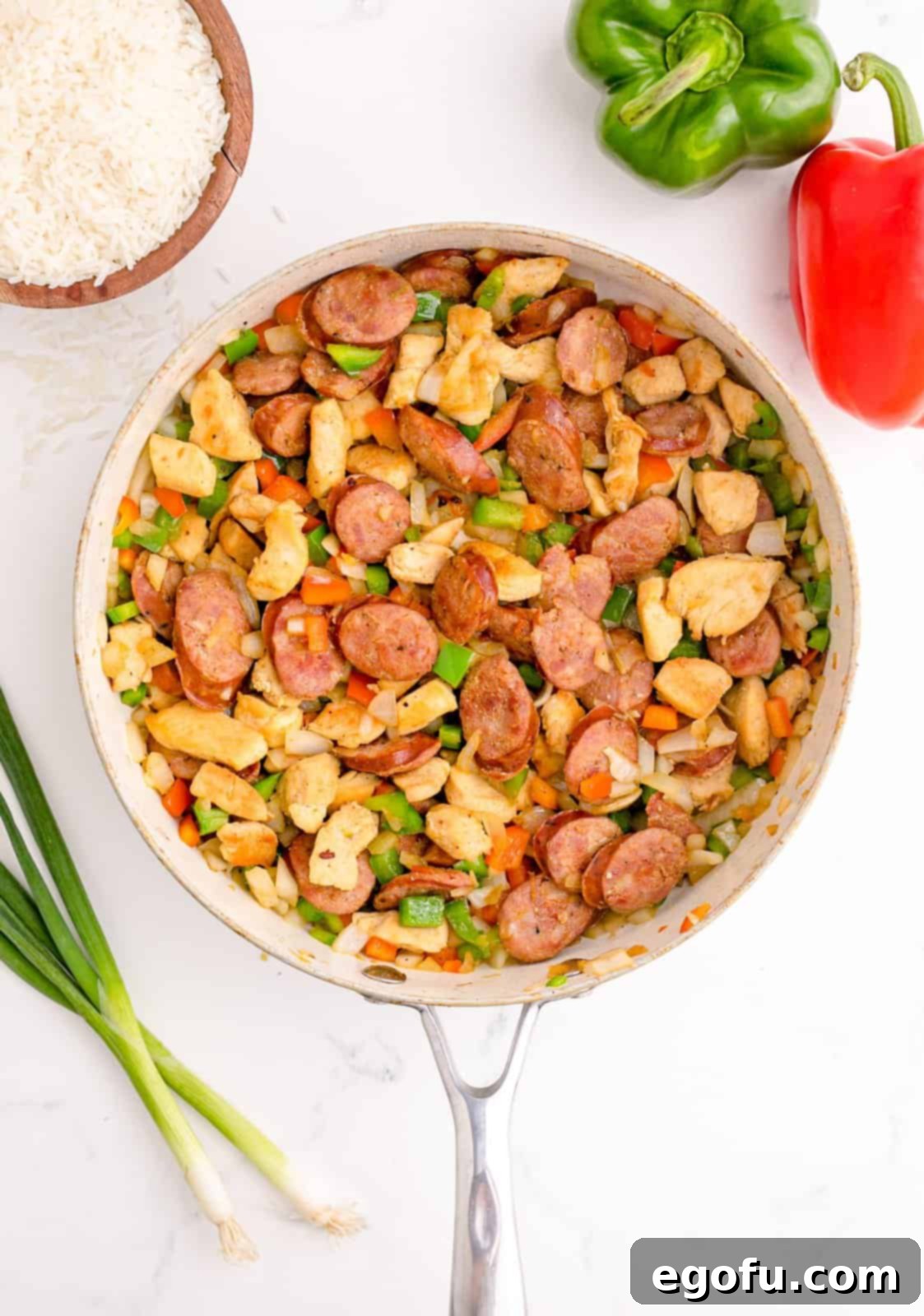
Step 3: Introduce Garlic and Tomatoes. Stir in the minced garlic and cook for just 1 minute until fragrant. Be careful not to burn the garlic. Next, add the 14-ounce can of crushed tomatoes, smoked paprika, salt, cumin, dried oregano, dried basil, dried thyme, black pepper, and cayenne pepper (if using). Stir these ingredients thoroughly, ensuring all the spices are well incorporated and the tomatoes begin to meld with the vegetables and meats. This is where the rich, “red” Creole base truly begins to form.
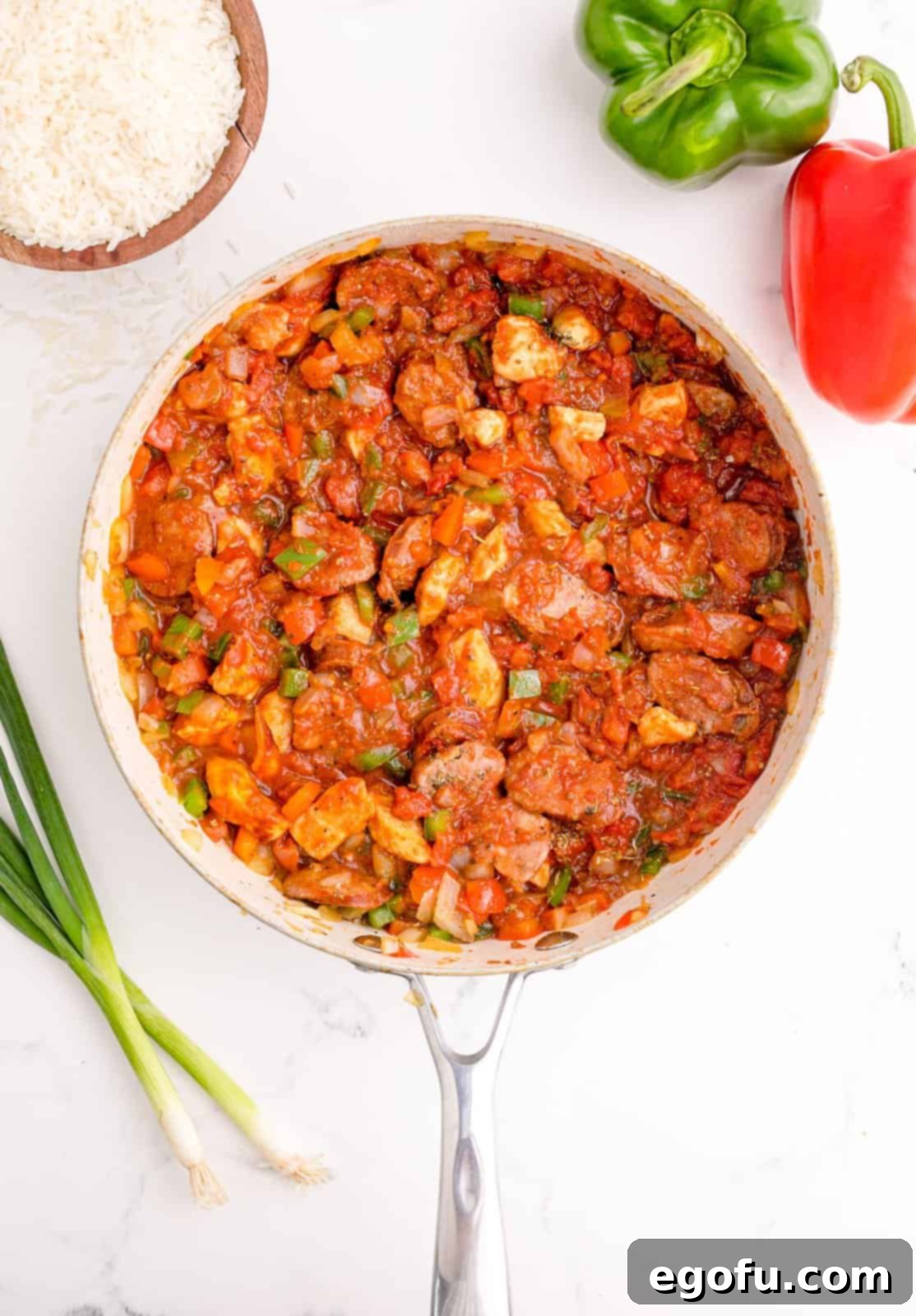
Step 4: Add Rice and Broth, Then Simmer. Now, stir in the 1 cup of uncooked white rice and 2 cups of chicken broth. Bring the entire mixture to a rolling boil. Once boiling, immediately reduce the heat to medium-low, cover the pot tightly, and allow it to simmer gently. The rice will need about 20 minutes to cook through, absorbing the flavorful liquid. Remember to stir the Jambalaya every few minutes to prevent the rice from sticking to the bottom and to ensure even cooking.
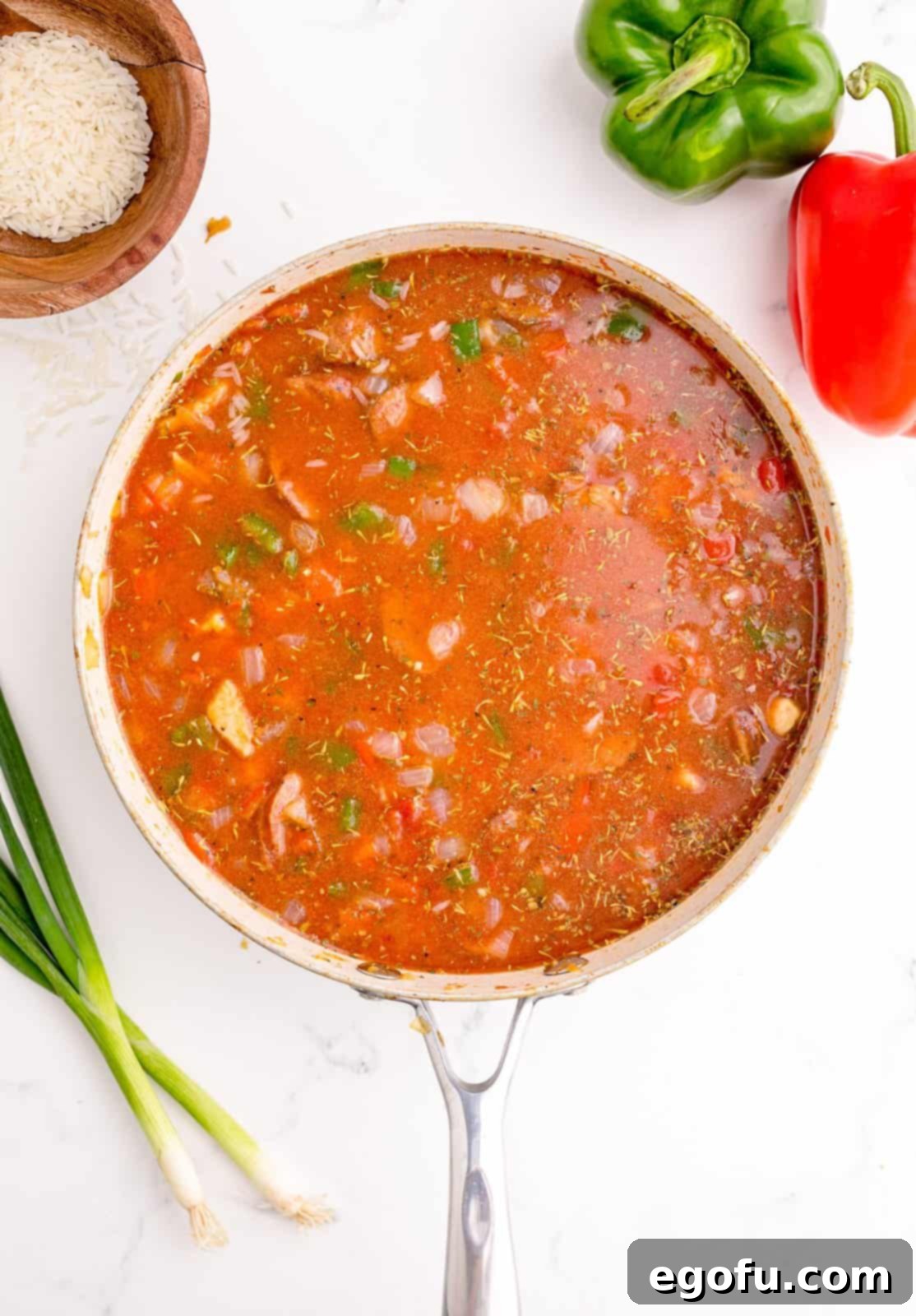
Step 5: Incorporate Shrimp. Once the rice is just cooked and most of the liquid has been absorbed, it’s time to add the final protein: the shrimp. Gently stir in the 1 pound of peeled and deveined shrimp. They cook very quickly, so adding them at this stage ensures they remain tender and don’t become rubbery.

Step 6: Final Simmer and Serve. Cover the pot once more and allow the Jambalaya to simmer for another 5 minutes, or until the shrimp are fully cooked and turn pink and opaque. The exact time may vary slightly depending on the size of your shrimp. Once cooked, remove from heat, let it rest for a few minutes, then fluff with a fork. Garnish generously with freshly sliced green onions (optional, but highly recommended for a fresh counterpoint). Serve your incredible Louisiana Jambalaya immediately and enjoy!
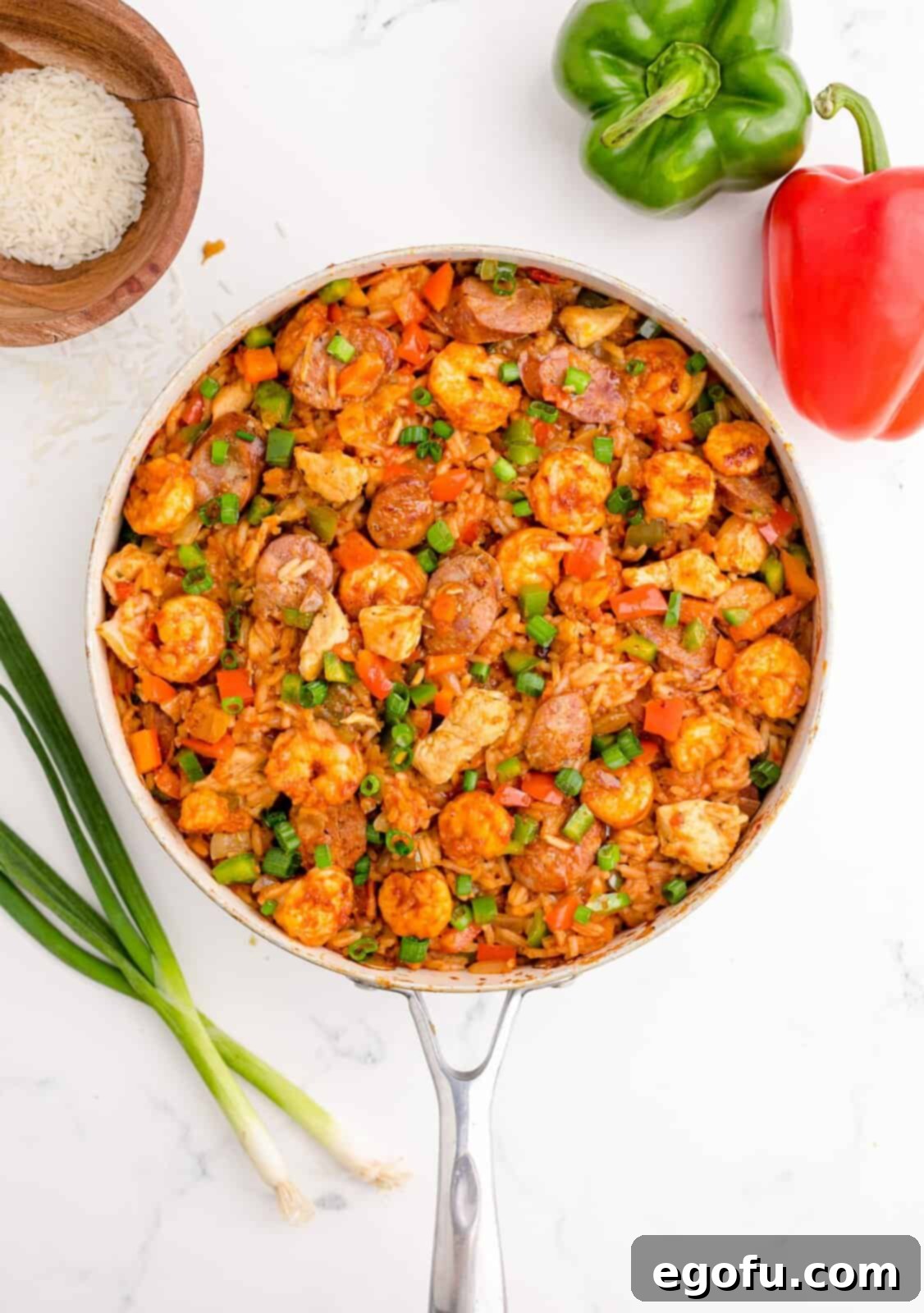
Garnish with sliced green onions for a fresh touch. Serve immediately and savor the rich, complex flavors of authentic Louisiana cooking. Pair it with a simple side salad or crusty bread to complete your meal.
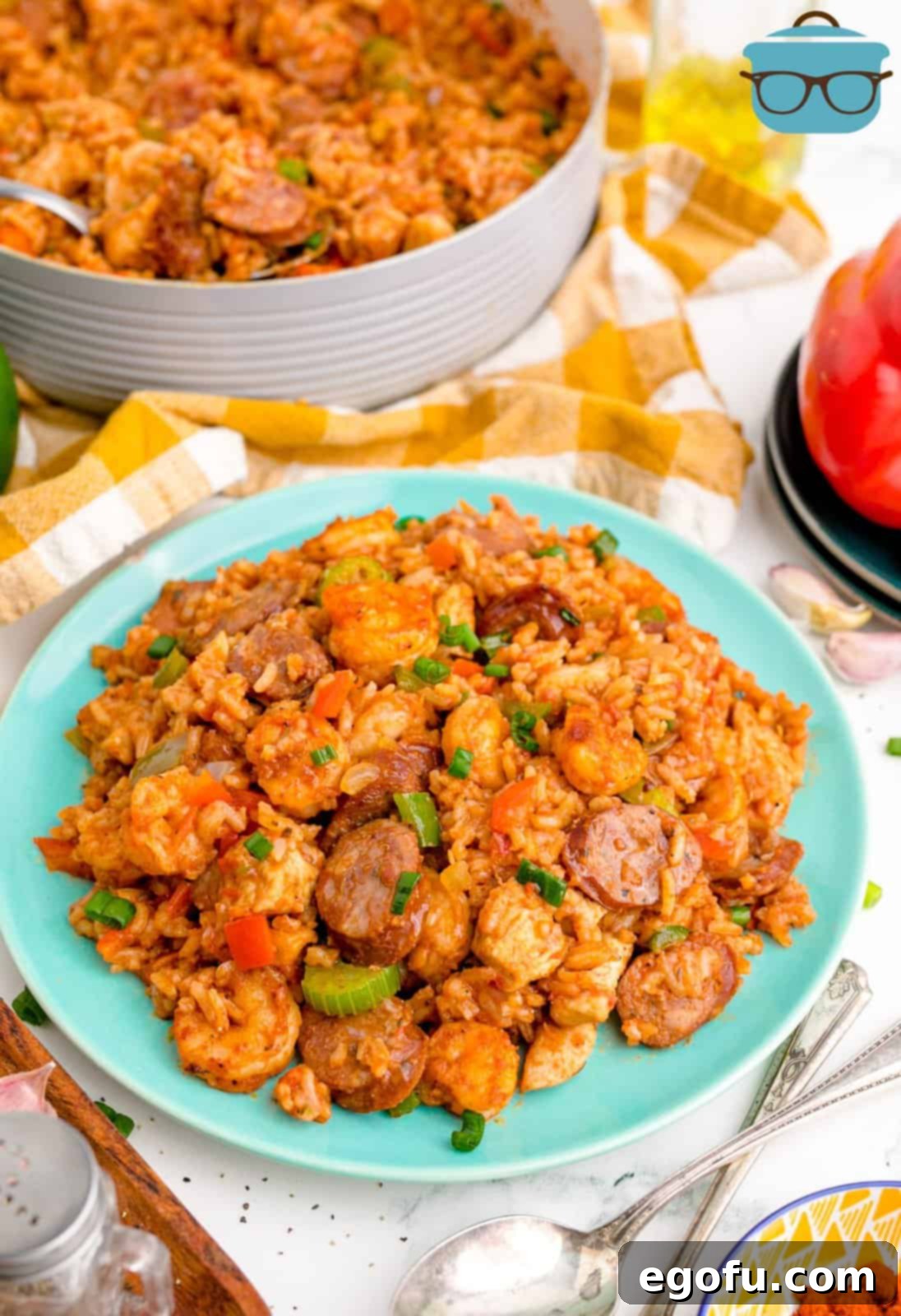
Explore More Delicious Southern and New Orleans Recipes
If you loved this authentic Louisiana Jambalaya, you’ll surely want to explore more culinary delights from the South. These recipes are perfect for expanding your repertoire of flavorful, comforting dishes:
- Southern Fried Shrimp
- Southern Shrimp Gumbo
- Shrimp Étouffée
- Red Beans and Rice
- Fried Okra
- Cajun Rice
- Shrimp Po Boys
- Chicken Étouffée
- Crock Pot Shrimp Boil
- Fried Green Tomatoes
- Southern Buttermilk Biscuits

Louisiana Jambalaya
Print
Pin
15 minutes
40 minutes
55 minutes
6
Brandie Skibinski
Ingredients
- 1 Tablespoon cooking oil
- 8 ounces andouille sausage cut into ¼ inch slices
- 1 pound boneless, skinless chicken breasts or thighs, cut into 1 inch pieces
- 1 yellow onion, finely diced
- 1 green bell pepper, seeds removed and diced
- 1 red bell pepper, seeds removed and diced
- 3 stalks celery, chopped
- 2 cloves garlic, minced
- 14 ounce can crushed tomatoes
- 1 Tablespoon smoked paprika
- 1 teaspoon salt
- 1 teaspoon cumin
- ½ teaspoon dried oregano
- ½ teaspoon dried basil
- ½ teaspoon dried thyme
- ½ teaspoon pepper
- ¼ teaspoon cayenne pepper
- 1 cup uncooked white rice (long or short grain – not quick cooking)
- 2 cups chicken broth
- 1 pound shrimp, peeled and deveined
- chopped green onion (for topping, optional)
Instructions
- Heat 1 tablespoon of cooking oil over medium heat in a large Dutch oven or heavy-bottomed pot. Add the cut Andouille sausage and chicken pieces, then fry until they are lightly seared and browned, about 5-7 minutes. This step is crucial for building the foundational flavors.
- Add the finely diced yellow onion, green bell pepper, red bell pepper, and chopped celery to the pot. Cook, stirring occasionally, until the onion softens and becomes translucent, about 5-8 minutes.
- Stir in the minced garlic and cook for just 1 minute until fragrant. Be careful not to let it burn.
- Next, add the crushed tomatoes, smoked paprika, salt, cumin, dried oregano, dried basil, dried thyme, black pepper, and cayenne pepper. Stir well to combine all ingredients and ensure the spices are evenly distributed.
- Stir in the uncooked white rice and chicken broth, ensuring the rice is fully submerged in the liquid.
- Bring the mixture to a boil, then immediately reduce the heat to medium-low. Cover the pot tightly and allow it to simmer until the rice is just cooked and has absorbed most of the liquid, approximately 20 minutes. Stir gently every few minutes to prevent sticking.
- Gently stir in the peeled and deveined shrimp.
- Cover the pot again and continue to simmer for another 5 minutes, or until the shrimp are fully cooked, pink, and opaque. The cooking time for shrimp can vary based on their size.
- Remove from heat, let stand for a few minutes, then fluff with a fork. Garnish with freshly chopped green onions, if desired, and serve your delicious Louisiana Jambalaya immediately.
Notes & Expert Tips
- Protein Choices: Feel free to use all three meats (chicken, sausage, shrimp) for the richest flavor, or select any combination you prefer. Each protein contributes its unique texture and taste.
- Sausage Alternatives: While Andouille sausage is traditional, you can substitute it with kielbasa, smoked sausage, or chorizo if you’re looking for different spice levels or flavors, as mentioned in the FAQ.
- Customizing Spices: For convenience, a quality pre-mixed Cajun seasoning can be used in place of the individual spices. However, the precise spice blend in this recipe is designed to create a perfectly balanced and authentic flavor profile.
- Freezing for Later: This Jambalaya recipe is freezer-friendly! Follow the storage instructions in the FAQ to enjoy this hearty meal another day. Note that shrimp texture might change slightly after freezing.
- Brown Rice Option: If you prefer brown rice, remember to increase the liquid (chicken broth) by about 1 cup and extend the simmering time until the rice is fully tender.
- Avoiding Mushy Rice: Resist the urge to stir the Jambalaya too often while the rice is cooking. Excessive stirring can release too much starch, leading to a mushy texture. A gentle stir every few minutes is sufficient.
- Adjusting Heat: The amount of cayenne pepper can be adjusted to your personal preference. For a milder dish, reduce or omit it. For more heat, add a pinch more!
Main Course
American, Creole, Cajun, Southern
Nutrition Information (Estimated Per Serving)
Nutritional Disclaimer
“The Country Cook” is not a dietician or nutritionist, and any nutritional information shared is an estimate. If calorie count and other nutritional values are important to you, we recommend running the ingredients through whichever online nutritional calculator you prefer. Calories and other nutritional values can vary quite a bit depending on which brands were used.
Did you make this recipe?
Share it on Instagram @thecountrycook and mention us #thecountrycook!
